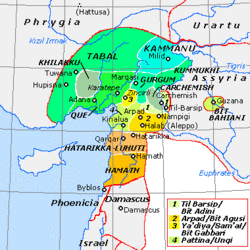
Back Kumaha ALS كوموه Arabic Kummukh Catalan Kummuḫ German Kummuh Spanish Կումմուխ Armenian ქუმუხი Georgian Samsat Höyük Dutch Kummuh Polish Kummuhu Turkish
Kummuh Kummaḫa | |||||||||
|---|---|---|---|---|---|---|---|---|---|
| Unknown–708 BC | |||||||||
 Kummuh among the Neo-Hittite states | |||||||||
| Capital | Kummuh | ||||||||
| Common languages | Hieroglyphic Luwian | ||||||||
| Religion | Luwian religion | ||||||||
| Government | Monarchy | ||||||||
| Historical era | Iron Age | ||||||||
• Established | Unknown | ||||||||
• Disestablished | 708 BC | ||||||||
| |||||||||
| Today part of | Turkey | ||||||||
Kummuh was an Iron Age Neo-Hittite kingdom located on the west bank of the Upper Euphrates within the eastern loop of the river between Melid and Carchemish. Assyrian sources refer to both the land and its capital city by the same name. The city is identified with the classical-period Samosata (modern-day Samsat Höyük), which has now been flooded under the waters of a newly built dam. Urartian sources refer to it as Kummaha.[1] The name is also attested in at least one local royal inscription dating to the 8th century BCE.[2] Other places that are mentioned in historical sources as lying within Kummuh are lands of Kištan and Halpi, and cities of Wita, Halpa, Parala, Sukiti and Sarita(?).[3] Kummuh bordered the kingdoms of Melid to the north, Gurgum to the west and Carchemish to the south, while to the east it faced Assyria and later Urartu.
Several indigenous rock inscriptions have been found in the region, all written in Hieroglyphic Luwian, attesting to the continuity of Hittite traditions. In his annals, the Assyrian king Sargon II referred to the Kummuh ruler as 'Hittite', and several rulers of Kummuh bore the same names as famous Hittite kings of the 2nd millennium BCE: Hattušili(?), Šuppiluliuma, and Muwattalli (in Assyrian sources Qatazilu, Ušpilulume, and Muttallu, respectively).[4]
- ^ Kummuhi as it appears in Assyrian sources should not be confused with Katmuhi which is a separate settlement on the bank of Tigris. Hawkins, J. D. (2000) Corpus of Hieroglyphic Luwian Inscriptions, v1, part 1, p. 330.
- ^ See Malpınarı Rock Inscription
- ^ Hawkins, Corpus, p. 331.
- ^ Hawkins, J. D. (1983) Reallexicon der Assyriologie 6, p. 338.